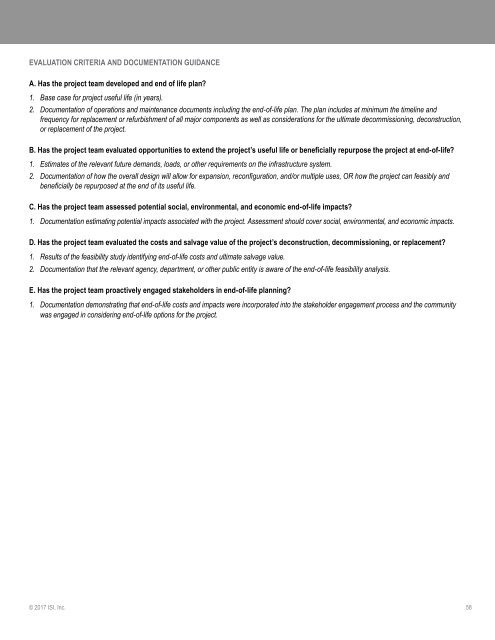EnvisionV3-LOA-table-option
Create successful ePaper yourself
Turn your PDF publications into a flip-book with our unique Google optimized e-Paper software.
2. EVALUATION Documentation CRITERIA of operations AND DOCUMENTATION and maintenance documents GUIDANCE<br />
including the end-of-life plan. The plan includes at minimum the timeline and<br />
frequency for replacement or refurbishment of all major components as well as considerations for the ultimate decommissioning, deconstruction,<br />
A. Has or replacement the project of team the project. developed and end of life plan?<br />
1. Base case for project useful life (in years).<br />
B. Has the project team evaluated opportunities to extend the project’s useful life or beneficially repurpose the project at end-of-life?<br />
2. Documentation of operations and maintenance documents including the end-of-life plan. The plan includes at minimum the timeline and<br />
1. Estimates frequency of for the replacement relevant future or refurbishment demands, loads, of all major other components requirements as on well the as infrastructure considerations system. for the ultimate decommissioning, deconstruction,<br />
2. Documentation or replacement of how the project.<br />
the overall design will allow for expansion, reconfiguration, and/or multiple uses, OR how the project can feasibly and<br />
beneficially be repurposed at the end of its useful life.<br />
B. Has the project team evaluated opportunities to extend the project’s useful life or beneficially repurpose the project at end-of-life?<br />
C. 1. Has Estimates the project of the relevant team assessed future demands, potential loads, social, or environmental, other requirements and on economic the infrastructure end-of-life system.<br />
impacts?<br />
1. 2. Documentation estimating of how the potential overall design impacts will associated allow for expansion, with the project. reconfiguration, Assessment and/or should multiple cover uses, social, OR environmental, how the project and can economic feasibly impacts. and<br />
beneficially be repurposed at the end of its useful life.<br />
D. Has the project team evaluated the costs and salvage value of the project’s deconstruction, decommissioning, or replacement?<br />
C. Has the project team assessed potential social, environmental, and economic end-of-life impacts?<br />
1. Results of the feasibility study identifying end-of-life costs and ultimate salvage value.<br />
2.<br />
1. Documentation<br />
Documentation estimating that the relevant<br />
potential agency,<br />
impacts department,<br />
associated or<br />
with other<br />
the public<br />
project. entity<br />
Assessment is aware<br />
should of the end-of-life<br />
cover social, feasibility<br />
environmental, analysis.<br />
and economic impacts.<br />
E.<br />
D. Has Has<br />
the the<br />
project project<br />
team team<br />
evaluated proactively<br />
the engaged<br />
costs and stakeholders<br />
salvage value in end-of-life<br />
of the project’s planning?<br />
deconstruction, decommissioning, or replacement?<br />
1.<br />
1. Documentation<br />
Results of the feasibility demonstrating<br />
study identifying that end-of-life<br />
end-of-life costs<br />
costs and impacts<br />
and ultimate were<br />
salvage incorporated<br />
value.<br />
into the stakeholder engagement process and the community<br />
2. was Documentation engaged in that considering the relevant end-of-life agency, <strong>option</strong>s department, for the or project. other public entity is aware of the end-of-life feasibility analysis.<br />
E. Has the project team proactively engaged stakeholders in end-of-life planning?<br />
DESCRIPTION<br />
1. Documentation demonstrating that end-of-life costs and impacts were incorporated into the stakeholder engagement process and the community<br />
was engaged in considering end-of-life <strong>option</strong>s for the project.<br />
This credit addresses the need to anticipate costs and impacts of project refurbishment or replacement and completes the series of planning credits<br />
that includes sustainable project identification and efficient low-impact operations and maintenance. Given the long life of infrastructure careful<br />
consideration is not always given to the projects end of useful life. For many projects the default assumption is that the project will continue<br />
indefinitely with periodic refurbishment.<br />
PERFORMANCE IMPROVEMENT<br />
This credit encourages project teams to consider the costs and impacts associated with a project’s end-of-life. In doing so, consideration should be<br />
given to extending the useful life of the project by enabling reconfiguration, future expansion, or flexibility, or by finding a beneficial use for the<br />
project. The longer the useful life of the project, the less it will need to be replaced, substantially reducing the energy, water, and materials required<br />
for a rebuild.<br />
The credit assessment begins with developing an end-of-life plan that includes the replacement or refurbishment for major project components and<br />
the ultimate decommissioning, deconstruction, or replacement of the project.<br />
There are many instances where infrastructure is currently operating under conditions that exceed its original design parameters. This causes<br />
accelerated degradation of the asset and speeds its end-of-life. Project teams should anticipate future loads and incorporate them into the project in<br />
order to prolong the project life. This can be achieved through incorporating capacity for reconfiguration, future expansion, or flexibility.<br />
Project teams should also consider the ultimate end-of-life impacts of the project. For example, whether decades of operation will render the site<br />
contaminated or otherwise environmentally damaged. These impacts are ultimately borne by the community and therefore they should be actively<br />
engaged in understanding the associated trade-offs and end-of-life costs and impacts.<br />
© 2017 ISI, Inc. 58



